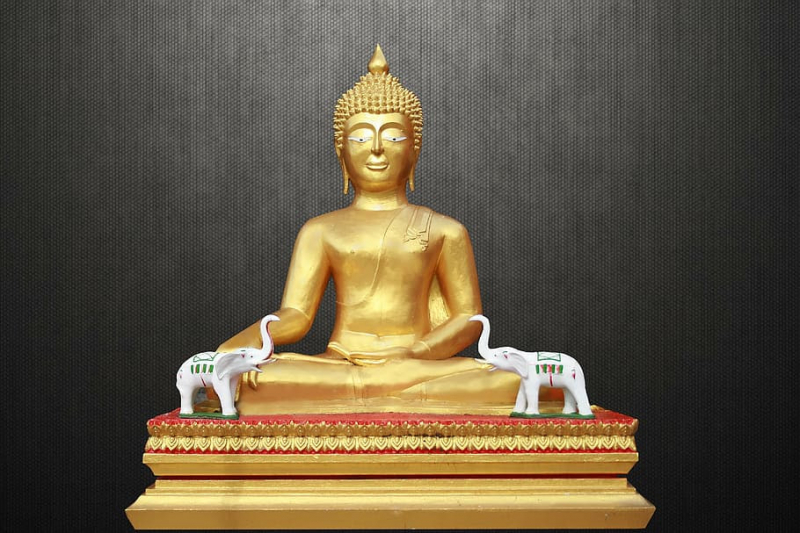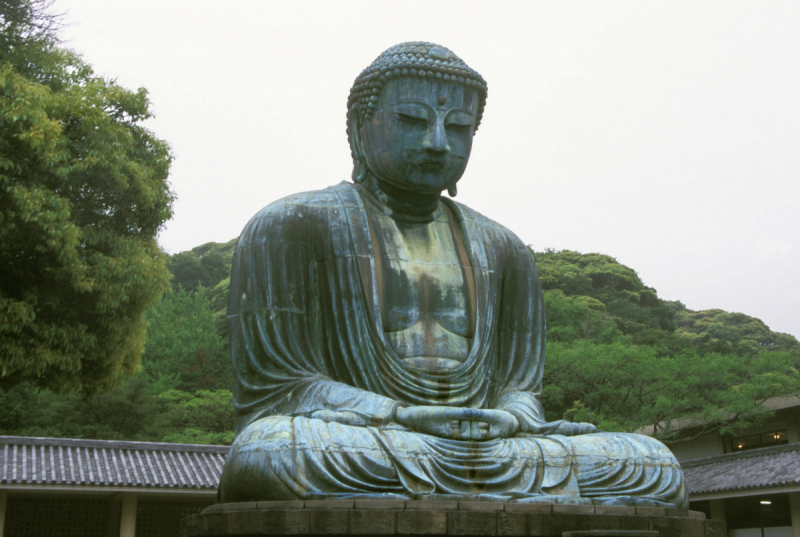Top 7 Essential Factors of Awakening
The seven essential factors of awakening are qualities or factors emphasized in Buddhist teachings as necessary for cultivating awakening or enlightenment. ... read more...These factors are instrumental in progressing to liberation and are often practiced in meditation and daily life.
-
Mindfulness (sati) is one of the essential factors of awakening in Buddhism. It serves as an underlying cornerstone supporting the entire path to enlightenment. Mindfulness involves immersing oneself fully in the present moment, skillfully observing thoughts, emotions, bodily sensations, and the surrounding environment without becoming entangled in attachment or judgment.
Mindfulness is a purposeful practice involving the intentional direction of one's attention. This means actively engaging in the observation of experiences rather than passively allowing the mind to wander. Encouraging a focus on the immediate present, mindfulness discourages preoccupation with the past or anxieties about the future.
Mindfulness helps develop equanimity, the ability to remain balanced and calm even in the face of challenging or intense experiences. Consistent mindfulness practice often leads to insights into the transient nature of all phenomena. By witnessing experiences ebb and flow, a comprehension emerges that nothing remains immutable or fixed.
Regular mindfulness yields myriad benefits, encompassing stress reduction, improved focus, adept emotional regulation, enriched relationships, cultivated insight and wisdom, and progress toward spiritual growth.
Mindfulness can be engaged formally through structured meditation or informally during everyday activities by infusing focused awareness into each endeavor. Approaching mindfulness with patience and an attitude of non-striving is paramount, recognizing that skill in this practice flourishes over time through dedicated commitment.

Photo on Wikimedia Commons (https://commons.wikimedia.org/wiki/File:Mindfulness-present-moment-here-now-awareness-symbol-logo.png) Video by Handful OfLeaves -
The investigation, known as Dhamma Vicaya, is another vital factor among the Essential Factors of Awakening in Buddhism. This practice involves delving deeply into the nature of reality, the teachings of the Buddha, and one's own experiences. It spurs practitioners to question and explore their thoughts, emotions, and experiences, fostering introspective inquiry that illuminates the intricate patterns and inclinations of the mind.
Central to the investigation is the act of scrutinizing assumptions and convictions, both concerning oneself and the world. Through the challenge of preconceived notions, individuals can unearth profound verities. This practice often revolves around the three fundamental characteristics of existence as taught by the Buddha: impermanence (anicca), unsatisfactoriness (dukkha), and non-self (anatta).
Investigation harmonizes seamlessly with mindfulness and meditation. While mindfulness unveils the contents of the mind, investigation plunges further into comprehending those contents. As a complementary practice, it nurtures wisdom and insight, enabling a richer understanding of one's experiences.
Embedding investigation into daily life entails regular contemplation of experiences, inquiry into assumptions, and reflection on the teachings. This endeavor transcends mere intellectual analysis, urging practitioners to interact with the instructions in ways that catalyze direct experiential realization. Ultimately, investigation unravels the layers of illusion and attains a profound grasp of truth, thus steering individuals toward a deeper state of awakening.

Photo on Wallpaper Flare Video by Samatha Buddhist Meditation -
Energy (Viriya) is a key component among Buddhism's Essential Factors of Awakening. It represents a crucial driving force toward enlightenment, fueling one's dedication and perseverance in practice. In the context of awakening, energy embodies the spirited enthusiasm and unwavering commitment that practitioners invest in their spiritual voyage. It propels individuals to overcome obstacles, laziness, and distractions, advancing on the path.
Characterized by unwavering resolve and persistent application, energy empowers practitioners to pursue their spiritual objectives vigorously. This indomitable force emboldens individuals to confer nt and surmount the mental hindrances that hinder progress, such as doubt, restlessness, and resistance. While energy is essential, it should be balanced to avoid excessive striving or burnout.
Cultivating energy involves setting clear intentions, establishing a routine for practice, and making a conscious effort to stay engaged. Striking a harmonious equilibrium, energy intertwines with other factors like mindfulness and tranquility, safeguarding against fatigue and rigidity.
The effort is not solely about intensive practice but also nurturing a positive and joyful attitude toward the path. Practitioners are encouraged to acknowledge and celeb ate even the most minor strides in their progress, drawing inspiration from their personal growth. Ultimately, energy emerges as a dynamic and propelling force that guides individuals on their path to awakening, ensuring their commitment, diligence, and unwavering persistence remain steadfast.

Photo on Wikimedia Commons (https://commons.wikimedia.org/wiki/File:Phra_Ajan_Jerapunyo-Abbot_of_Watkungtaphao..jpg) Video on Secession Studios -
Piti, known as "joy" in the Pali language, emerges as a pivotal mental facet within Buddhist teachings, notably in meditation and pursuing enlightenment. Piti represents a profound and exuberant sense of delight, happiness, and joy that arises during the course of practice. This isn't a transient and fleeting pleasure but a deep and wholesome inner contentment and bliss.
Piti assumes both a physical and mental presence. On a physical level, it might manifest as tingling sensations, warmth, or even a palpable surge of energy coursing through the body. Mentally, it manifests as an elevated state of happiness and joy. Joy exists on a spectrum, ranging from subtle contentment to more intense and euphoric experiences.
Its role as a potent motivator for practice is particularly pronounced. The encounter with joy elevates the appeal and gratification of meditation and spiritual devotion, providing practitioners with the impetus to persist. Moreover, the joyful experience reinforces the conviction that the journey toward enlightenment yields immense benefits, fueling enthusiasm and unwavering dedication.
Furthermore, the physical sensations of joy establish a harmonious connection between mind and body, fostering vitality and overall well-being. However, it's paramount not to succumb to attachment to joy. Clinging to satisfaction can spark a craving that obstructs the cultivation of profound meditative states. Advanced practitioners cultivate equanimity, allowing joy to arise and subside without becoming entangled in attachment.

Photo on Pxuel 
Photo on Wikimedia Commons (https://commons.wikimedia.org/wiki/File:042_The_Awakening_%289014385016%29.jpg) -
Tranquility (Passaddhi) is indeed one of the Essential Factors of Awakening in Buddhism. Tranquility refers to the inner calm, stillness, and peacefulness that arises through meditation and spiritual practice. Tranquility involves cultivating a serene and undisturbed internal state. A sense of quietness and non-reactivity characterizes it in the mind.
Tranquility is integral to mindfulness and meditation, and it's often developed in conjunction with focused attention techniques. By cultivating tranquility, practitioners can achieve a balanced state of mind that is less susceptible to the agitations of daily life and the challenges of the external world. It promotes relaxation, mental clarity, and a deeper connection to the present moment.
In the Essential Factors of Awakening context, tranquility complements qualities such as mindfulness, investigation, energy, joy, concentration, and stability. It stabilizes, enabling practitioners to engage with their experiences and insights with a composed, open-hearted attitude.
Tranquility not only enhances meditation but also extends its benefits to everyday life. Through its development, practitioners can navigate life's complexities with greater resilience, responding to situations from a place of inner calm rather than reactivity.
In essence, tranquility is a vital component contributing to the transformative journey of awakening. It fosters a peaceful mind, nurtures concentration, and fosters a deeper understanding of reality. By cultivating tranquility, individuals create an inner sanctuary that supports their spiritual growth and leads them closer to the realization of enlightenment.

Photo on Wikimedia Commons (https://commons.wikimedia.org/wiki/File:041_The_Awakening_%289014393786%29.jpg) Video by Dhamma Dayada -
Concentration (Samadhi) is significant among the Essential Factors of Awakening in Buddhism. It entails the unwavering focus of the mind on a chosen object or theme, resulting in profound mental absorption and heightened clarity. In spiritual development, concentration serves as a cornerstone, stabilizing the mind and paving the way for the cultivation of insight and wisdom.
Concentration involves honing the mind's ability to sustain focused attention on a selected focal point while gradually disregarding distractions and scattered thoughts. As concentration deepens, it leads to states of mental absorption, where the boundaries between the observer and the observed begin to dissolve. This dissolution sharpens the mind's clarity, enabling practitioners to perceive reality in its unadulterated form. This newfound clarity lays the foundation for nurturing wisdom and insight into the fundamental nature of existence.
The journey toward developing concentration unfolds through consistent meditation practice. Various techniques are employed, often centered around directing the mind's focus onto a specific object—a breath, a visual symbol, or a mantra. These techniques are conduits to honing concentration and experiencing its transformative effects.
In summation, concentration stands as a vital and transformative Essential Factor of Awakening. It amplifies mental clarity, engenders states of absorption, and augments insight. As practitioners diligently cultivate concentration, they forge a stable bedrock from which the seeds of wisdom can flourish, ultimately guiding them to enlightenment.

Photo on flickr (https://www.flickr.com/photos/fotograzio/24032664985) Video by ArshaBodha - Swami Tadatmananda -
Equanimity (Upekkha) is one of the Essential Factors of Awakening in Buddhism. It denotes a poised and impartial state of mind that stands unaffected by the oscillations of pleasure and pain, gain and loss, and success and failure. This quality involves upholding an emotionally balanced and even-handed approach to experiences, whether pleasing or challenging.
Equanimity empowers practitioners to embrace life's occurrences without an excessive grip on their outcomes. It signifies an impartial demeanor that treats all individuals with parity, irrespective of their circumstances. A mind that embodies equanimity remains steadfast against the storms of external events, tempering impulsive reactions in favor of thoughtful responses.
Cultivating equanimity involves incorporating mindfulness and insight practices, prompting practitioners to observe their reactions and attachments without passing judgment. It is crucial to emphasize that peace is not equivalent to apathy. Instead, it arises as a quality rooted in profound interconnectedness and compassion for all sentient beings.
While equanimity bears immense value, it is vital to harmonize it with other Essential Factors of Awakening. Striking this equilibrium fortifies emotional equilibrium, diminishes suffering, augments wisdom, and nurtures harmonious relationships. Through its nurturing, practitioners forge an unswerving and unbiased mental stance capable of navigating the ever-changing currents of life with serenity and grace.

Photo on pxhere (https://pxhere.com/en/photo/658353) Video by Yuval Ron Music




























